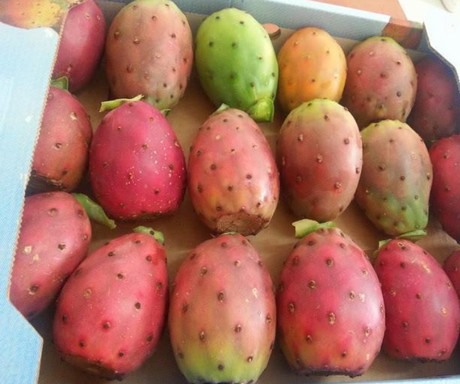In Italy, prickly pears are grown mainly in Sicily over more than 3500 hectares. Most of the production is commercialized in Italy, while the remaining part is exported to European countries and Canada. Fruits are commercialized immediately after being harvested and post-harvesting treatments and handling procedures are rather simple.
Once at the packing facility, fruits are unloaded on packing lines and taken to a series of brushes that remove the spines and make the peel shinier. Fruits are then sorted and placed in single-layer containers and in plastic or cardboard crates.
Despite the high perishability and susceptibility to lesions caused by chilling, fruits remain fresh and decay losses are insignificant, also thanks to the short time between harvesting and consumption.

Demand for prickly pears is constantly increasing therefore, in order to meet out-of-season demand for fresh fruit in the near future, the industry needs to develop suitable post-harvest treatments and technologies to mitigate the damage caused by cold temperatures in the fruit destined to long-term storage.
In addition, to increase the sales volumes in new markets, quarantine measures to prevent the spreading of parasites such as the Mediterranean fruit fly (Ceratitis capitata) must be guaranteed when required.
The most popular prickly pear varieties in Italy are the Gialla or Sulfarina, Bianca or Muscaredda and Rossa or Sanguigna. The Gialla variety is the most popular due to its high productivity and good adaptability to intensive cultivation method. The Bianca variety is appreciated for its unique flavor, while the Rossa one is particularly appealing for its deep red color due to the high betaxanthin e betacyanin level.
Producers tend to grow the three cultivars in the same orchard and all three fruits are often placed in the same tray for a more colorful impact
Despite the economic relevance of these three cultivars, Italian post-harvesting studies focus mainly on the Gialla variety and on the temperature modes of cold storage protocols for fresh produce."
"Although Italy is the second leading prickly pear producer behind Mexico, handling and post-harvesting treatments are rather simple, as fruit is commercialized immediately after harvesting. However, as demand for fresh fruit beyond the harvesting period is constantly on the up, the industry will probably have to implement post-harvesting treatments and technologies that can widen the commercial window in the near future," explain researchers from CNR Sassari and Agris Sardegna.
"New markets in which the introduction of the Mediterranean fruit fly is considered risky can only be reached if fruit is subjected to approved quarantine protocols. A study was therefore conducted to understand the post-harvesting behavior of the three main Italian cultivars undergoing cold quarantine treatment (3 weeks at 2°C) followed by either 1) one week of simulated marketing conditions at 20°C or 2) two weeks of storage at 8°C before the transfer to simulated marketing conditions at 20°C for three days."
"These storage conditions have not been implemented by packing houses so far, as fruits are commercialized immediately after harvesting. However, it could become a typical protocol should fruit be sold in countries that require approved cold quarantine treatments."
Results showed an abnormal increase in respiratory activity and ethylene production rates following transfer from cold storage at 20°C, especially after the two additional weeks at 8°C. Physiological peel disorders and quality decay incidence were slight at the end of storage at 2 or 8°C, while severe peel disorders occurred when fruits were transferred to 20°C. Peel damage, quality decay and loss of overall appearance were more severe for fruits stored for another two weeks at 8°C.
Among the three cultivars, susceptibility to chilling and decay were worse in Bianca. However, cold storage does not seem to affect the chemical and sensory quality of the fruit."
"Based on these results, only Gialla and Rossa seem to be able to endure cold quarantine treatments, however fruits should be commercialized immediately after, as not even these two cultivars can withstand further exposure to low temperatures. Further studies need to be conducted to identify post-harvesting treatments that can mitigate chilling damage and to clarify whether the damage and susceptibility to decay can be reduced when fruit is transferred."
Source: Salvatore D’Aquino, Daniela Satta, Luciano De Pau, Amedeo Palma, 'Effect of a cold quarantine treatment on physiological disorders and quality of cactus pear fruit', 2019, AIMS Agriculture and Food, Vol. 4(1), pag. 114-126. doi: 10.3934/agrfood.2019.1.114
